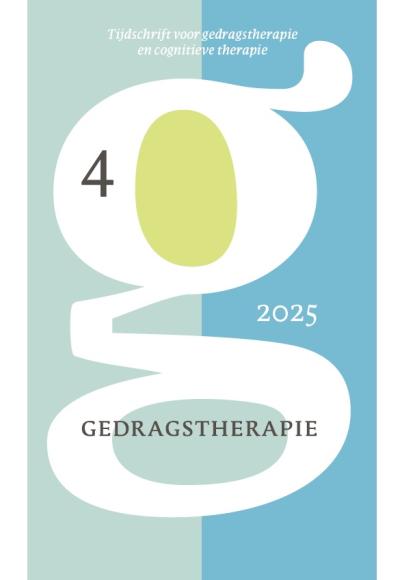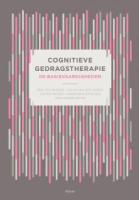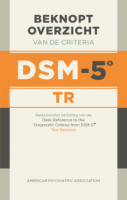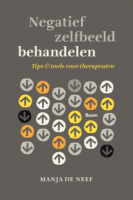Inhoud
De kloof overbruggen: het verbeteren van de disseminatie van CGT
Samenvatting
Er zijn empirisch ondersteunde psychologische behandelingen ontwikkeld voor verschillende psychiatrische stoornissen, maar er zijn aanwijzingen dat patiënten deze behandelingen in de reguliere geestelijke gezondheidszorg niet ontvangen. Daarnaast is er evidentie dat wanneer patiënten deze behandelingen wel ontvangen, ze vaak niet goed worden aangeboden. Het doel van dit artikel is het identificeren van de hindernissen bij de disseminatie van ‘evidence-based' psychologische behandelingen en het voorstellen van manieren om deze hindernissen te overwinnen en zo de kloof tussen onderzoeksbevindingen en de klinische praktijk te overbruggen.
Literatuur
- Aarons, G.A., Sommerfeld, D.H., Hecht, D.B., Silovsky, J. F., & Chaffin, M.J. (2009). The impact of evidence-based practice implementation and fidelity monitoring on staff turnover: evidence for a protective effective. Journal of Consulting and Clinical Psychology, 77, 270–280.
- Addis, M.E. (2002). Methods for disseminating research products and increasing evidence-based practice: promises, obstacles and future directions. Clinical Psychology: Science and Practice, 9, 367–378.
- Addis, M.E., Hatgis, C., Cardelmil, E., Jacob, K., Krasnow, A.D., & Mansfield, A. (2006). Effectiveness of cognitive-behavioral treatment for panic disorder versus treatment as usual in a managed care setting: 2-year follow-up. Journal of Consulting and Clinical Psychology, 74, 377–385. American Psychiatric Association. (2009). Treatment of patients with panic disorder (2nd ed.). APA Practice Guidelines.
- Andersson, G. (2009). Using the Internet to provide cognitive behaviour therapy. Behaviour Research and Therapy, 47, 175–180.
- Anderson, R.A., & Rees, C.S. (2007). Group versus individual cognitive-behavioural treatment for obsessive-compulsive disorder: A controlled trial. Behaviour Research and Therapy, 45, 123–137.
- Andrews, G.A., & Titov, N. (2009). Hit and miss: innovation and the dissemination of evidence based psychological treatments. Behaviour Research and Therapy, 47(11), 974–979.
- Asselt, A.D.I. van, Dirksen, C.D., Arntz, A., Giesen-Bloo, J.H., van Dyck, R., Spinhoven, Ph., et al. (2008). British Journal of Psychiatry, 192, 450–457.
- Barlow, D.H. (2004). Psychological treatments. The American Psychologist, 59, 869–878.
- Barlow, D.H., Levitt, J.T., & Bufka, L.F. (1999). The dissemination of empirically supported treatments: a view to the future. Behaviour Research and Therapy,37(Suppl. 1), S147–S162.
- Becker, C.B., Stice, E., Shaw, H., & Woda, S. (2009). Use of empirically supported interventions for psychopathology: can the participatory approach move us beyond the research-to-practice gap? Behaviour Research and Therapy, 47, 265–274.
- Becker, C.B., Zayfert, C., & Anderson, E. (2004). A survey of psychologists' attitudes towards and utilization of exposure therapy for PTSD. Behaviour Research and Therapy, 42, 277–292.
- Berry, K., & Haddock, G. (2008). The implementation of the NICE guidelines for schizophrenia: barriers to the implementation of psychological interventions and recommendations for the future. Psychology and Psychotherapy: Theory Research and Practice, 81, 419–436.
- Brewin, C.R., Scragg, P., Robertson, M., Thompson, M., d'Ardenne, P., & Ehlers, A. (2008). Promoting mental health following the London bombings: a screen and treat approach. Journal of Traumatic Stress, 21, 3–8.
- Brown, T.A., Antony, M.M., & Barlow, D.H. (1995). Diagnostic comorbidity in panic disorder: effect on treatment outcome and course of comorbid diagnoses following treatment. Journal Consulting and Clinical Psychology, 63, 408–418.
- Carroll, K.M., & Rounsaville, B.J. (2007). A vision of the next generation of behavioral therapies research in the addictions. Addiction, 102, 850–862.
- Chorpita, B.J., & Nakamura, B.J. (2004). Four considerations for dissemination of intervention innovations. Clinical Psychology: Science and Practice, 11, 364–367.
- Clark, D.M. Improving access to psychological therapies in England: a government initiative. Presentation, Symposium 57, 42nd Annual Convention, Association of Behavioral and Cognitive Therapy, Orlando, 13–16 November, 2008.
- Cook, J.M., Wiengardt, K.R., Jaszka, J., & Weisner, M. (2008). A content analysis of advertisements for psychotherapy workshops: implications for disseminating empirically supported treatments. Journal of Clinical Psychology, 64, 296–307.
- Crits-Christoph, P., Beebe, K.L., & Connolly, M.B. (1990). Therapist effects in the treatment of drug dependence: implications for conducting comparative treatment studies. NIDA Research Monograph, 104, 39–49.
- Crow, S., Mussell, M.P., Peterson, C., Knopke, A., & Mitchell, J. (1999). Prior treatment received by patients with bulimia nervosa. International Journal of Eating Disorders, 25, 39–44.
- Crow, S., & Peterson, C.B. (2009). Refining treatments for eating disorders. American Journal of Psychiatry, 166, 266–267.
- Cucciare, M.A., Weingardt, K.R., & Villafranca, S. (2008). Using blended learning to implement evidence-based psychotherapies. Clinical Psychology: Science and Practice, 15, 299–307.
- Currin, L.,Waller, G., Treasure, J., Nodder, J., Stone, C., Yeomans, M., et al. (2007). The use of guidelines for dissemination of 'best practice' in primary care of patients with eating disorders. International Journal of Eating Disorders, 40, 476–479.
- DeRubeis, R.J., & Feeley, M. (1990). Determinants of change in cognitive therapy for depression. Cognitive Therapy & Research, 14, 469–482.
- DeRubeis, R. J., Hollon, S. D., Amsterdam, J. D., Shelton, R. C., Young, P. R., Salomon, R. M., et al. (2005). Cognitive therapy vs. medications in the treatment of moderate to severe depression. Archives of General Psychiatry, 62, 409–416.
- Dimeff, L. A., Koerner, K., Woodcock, E. A., Beadnell, B., Brown, M. Z., Skutch, J. M., et al. (2009). Which training method works best? A randomized controlled trial comparing three methods of training clinicians in dialectical behavior therapy skills. Behaviour Research and Therapy, 47(11), 921–930.
- Dreessen, L., & Arntz, A. (1998). The impact of personality disorders on treatment outcome of anxiety disorders: best-evidence synthesis. Behaviour Research and Therapy, 36, 483–504.
- Dreessen, L., Arntz, A., Luttels, C., & Sallaerts, S. (1994). Personality disorders do not influence the results of cognitive behavior therapies for anxiety disorders. Comprehensive Psychiatry, 35, 265–274.
- Dreessen, L., Hoekstra, R., & Arntz, A. (1997). Personality disorders do not influence the results of cognitive and behavior therapy for obsessive compulsive disorder. Journal of Anxiety Disorders, 11, 503–521.
- Duffy, M., Gillespie, K., & Clark, D. M. (2007). Post-traumatic stress disorder in the context of terrorism and other civil conflict in Northern Ireland: randomized controlled trial. British Medical Journal, 334(7604), 1147.
- Ehlers, A., Clark, D. M., Hackmann, A., McManus, F., & Fennell, M. (2005). Cognitive therapy for post-traumatic stress disorder: development and evaluation. Behaviour Research and Therapy, 43, 413–431.
- Ehlers, A., Clark, D. M., Hackmann, A., McManus, F., Fennell, M., Herbert, C., et al. (2003). A randomized controlled trial of cognitive therapy, a self-help booklet, and repeated assessments as early interventions for posttraumatic stress disorder. Archives of General Psychiatry, 60, 1024–1032.
- Ehlers, A., Gene-Cos, N., & Perrin, S. (2009). Low recognition of posttraumatic stress dis order in primary care. London Journal of Primary Care, 1, 36–42.
- Ellis, P. M., Hickie, I., & Smith. (2003). Summary of guideline for the treatment of depression. Australasian Psychiatry, 11(1), 34–38.
- Fairburn, C. G. (2008). Cognitive behavior therapy and eating disorders. New York: Guilford Press.
- Fairburn, C. G., Cooper, Z., Doll, H. A., O'Connor, M. E., Bohn, K., Hawker, D. M., et al. (2009). Transdiagnostic cognitive-behavioral therapy for patients with eating disorders: a two-site trial with 60-week follow-up. American Journal of Psychiatry, 166, 311–319.
- Farrell, J. M., Shaw, I., & Webber, M. A. (2009). A schema-focused approach to group psychotherapy for outpatients with borderline personality disorder: a randomized controlled trial. Journal of Behavior Therapy and Experimental Psychiatry, 40, 317–328.
- Feeley, M., DeRubeis, R. J., & Gelfand, L. A. (1999). The temporal relation of adherence and alliance to symptom change in cognitive therapy for depression. Journal Consulting and Clinical Psychology, 67, 578–582.
- Foa, E. B., Hembree, E. A., Cahill, S. P., Rauch, S. A., Riggs, D. S., Feeny, N. C., et al. (2005). Randomized trial of prolonged exposure for PTSD with and without cognitive restructuring: outcome at academic and community clinics. Journal of Consulting and Clinical Psychology, 73, 955–964.
- Giesen-Bloo, J., van Dyck, R., Spinhoven, P., van Tilburg,W., Dirksen, C., van Asselt, T., et al. (2006). Outpatient psychotherapy for borderline personality disorder: randomized trial of schema-focused therapy vs. transference-focused psychotherapy. Archives of General Psychiatry, 63, 649–658.
- Gillespie, K., Duffy, M., Hackmann, A., & Clark, D. M. (2002). Community based cognitive therapy in the treatment of posttraumatic stress disorder following the Omagh bomb. Behaviour Research and Therapy, 40, 345–357.
- Goisman, R. M., Warshaw, M. G., & Keller, M. B. (1999). Psychosocial treatment prescriptions for generalized anxiety disorder, panic disorder and social phobia, 1991–1996. American Journal of Psychiatry, 156, 1819–1821.
- de Graff, L. E., Gerhards, S. A. H., Arntz, A., Riper, H., Metsemakers, J. F. M., Evers, S. M. A. A., et al. (2009). Clinical effectiveness of online computerized cognitive behavioural therapy without support for depression in primary care: a randomized trial. British Journal of Psychiatry, 195, 73–80.
- Grey, N., Salkovskis, P., Quigley, A., Clark, D. M., & Ehlers, A. (2008). Dissemination of cognitive therapy for panic disorder in primary care. Behavioural and Cognitive Psychotherapy, 36, 509–520.
- Grilo, C. M., Pagano, M. E., Skodol, A. E., Sanislow, C. A., McGlashan, T. H., Gunderson, J. G., et al. (2007). Natural course of bulimia nervosa and eating disorder not otherwise specified: 5-year prospective study of remissions, relapses, and the effects of personality disorder psychopathology. Journal of Clinical Psychiatry, 68, 738–746.
- Hahlweg, K., Fiegenbaum, W., Frank, M., Schroeder, B., & von Witzleben, I. (2001). Short- and long-term effectiveness of an empirically supported treatment for agoraphobia. Journal of Consulting and Clinical Psychology, 69, 375–382.
- Hirai, M., & Clum, G. A. (2006). A meta-analytic study of self-help interventions for anxiety problems. Behavior Therapy, 37, 99–111.
- Hollon, S. D., Evans, M. D., Elkin, I., Lowery, A. System for rating therapies for depression. Paper presented at the 92nd Annual Convention of the American Psychological Association, Toronto, Ontario, Canada, August 1984.
- House, R., & Loewenthal, D. (2008). Against and for CBT: Towards a constructive dialogue? Hertfordshire, UK: PCCS Books.
- Huppert, J. D., Bufka, L. F., Barlow, D. H., Gorman, J. M., Shear, M. K., & Woods, S. W. (2001). Therapists, therapist variables and cognitive behavioral therapy outcome in a multicenter trial for panic disorder. Journal of Consulting and Clinical Psychology, 69, 747–755.
- Insel, T. R. (2009). Translating scientific opportunity into public health impact: a strategic plan for research on mental illness. Archives of General Psychiatry, 66, 128–133.
- Jacobson, N. S., & Hollon, S. D. (1996). Prospects for future comparisons between drugs and psychotherapy: lessons from the CBT-versus-pharmacotherapy exchange. Journal of Consulting and Clinical Psychology, 64, 104–108.
- Kessler, R. C., Chiu,W. T., Demler, O., &Walters, E. E. (2005). Prevalence, severity and comorbidity of 12 month DSM-IV disorders in the national comorbidity survey replication. Archives of General Psychiatry, 62, 617–627.
- Kessler, R. C., Merikangas, K. R., & Wang, P. S. (2007). Prevalence, comorbidity and service utilization of mood disorders in the United States at the beginning of the twentyfirst century. Annual Review of Clinical Psychology, 3, 137–158.
- Kroenke, K. (2007). Efficacy of treatment for somatoform disorders: a review of randomized controlled trials. Psychosomatic Medicine, 69, 881–888.
- Layard, R., Clark, D. M., Knapp, M., & Mayraz, G. (October 2007). Cost–benefit analysis of psychological therapy. Centre for Economic Performance Discussion Paper No. 829. Web site. The Centre for Economic Performance Publications Unit. http://cep.lse.ac.uk.
- Lincoln, T. M., Rief, W., Hahlweg, K., Frank, M., von Witzleben, I., Schroeder, B., et al. (2003). Effectiveness of an empirically supported treatment for social phobia in the field. Behaviour Research and Therapy, 41, 1251–1269.
- Linehan, M. M., Comtois, K. A., Murray, A. M., Brown, M. Z., Gallop, R. J., Heard, H. L., et al. (2006). Two-year randomized controlled trial and follow-up of dialectical behavior therapy vs. therapy by experts for suicidal behaviors and borderline personality disorder. Archives of General Psychiatry, 63, 757–766.
- Loeb, K. L., Wilson, G. T., Labouvie, E., Pratt, E. M., Hayaki, J.,Walsh, B. T., et al. (2005). Therapeutic alliance and treatment adherence in two interventions for bulimia nervosa: a study of process and outcome. Journal of Consulting and Clinical Psychology, 73, 1097–1107.
- McAlpine, D. E., Schroder, K., Pankratz, S., & Maurer, M. (2004). Survey of regional health care providers on selection of treatment for bulimia nervosa. International Journal of Eating Disorders, 35, 27–32.
- McHugh, R. K., Murray, H. W., & Barlow, D. H. (2009). Balancing fidelity and adaptation in the dissemination of empirically-supported treatments: the promise of transdiagnostic interventions. Behaviour Research and Therapy, 47(11), 946–953.
- Mannix, K. A., Blackburn, I. M., Garland, A., Gracie, J., Moorey, S., Reid, B., et al. (2006). Effectiveness of brief training in cognitive behaviour therapy techniques for palliative care practitioners. Palliative Medicine, 20, 579–584.
- Miklowitz, D. J. (2006). A review of evidence-based psychosocial interventions for bipolar disorder. Journal of Clinical Psychiatry, 67(Suppl. 11), 28–33.
- Miller, W. R., Yahne, C. E., Moyers, T. B., Martinez, J., & Pirritano, M. (2004). A randomized trial of methods to help clinicians learn motivational interviewing. Journal of Consulting and Clinical Psychology, 72, 1050–1062.
- Mitchell, J. E., Crosby, R. D., Wonderlich, S. A., Crow, S., Lancaster, K., Simonich, H., et al. (2008). A randomized trial comparing the efficacy of cognitive-behavioral therapy for bulimia nervosa delivered via telemedicine versus face-to-face. Behaviour Research and Therapy, 46, 581–592.
- Morrison, A. P., Renton, J. C., Williams, S., Dunn, H., Knight, A., Kreutz, M., et al. (2004). Delivering cognitive therapy to people with psychosis in a community mental health setting: an effectiveness study. Acta Psychiatrica Scandinavia, 110, 36–44.
- Mörtberg, E., Clark, D. M., Sundin, O., & Aberg Wistedt, A. (2007). Intensive group cognitive treatment and individual cognitive therapy vs. treatment as usual in social phobia: a randomized controlled trial. Acta Psychiatrica Scandinavia, 115, 142–154.
- Murphy, R., Cooper, Z., Hollon, S. D., & Fairburn, C. G. (2009). How do psychological treatment work? Investigating mediators of change. Behaviour Research and Therapy, 47, 1–5.
- Mussell, M. P., Crosby, R. D., Crow, S., Knope, A. J., Peterson, C. B., Wonderlich, S. A., et al. (2000). Utilization of empirically supported psychotherapy treatments for individuals with eating disorders: a survey of psychologists. International Journal of Eating Disorders, 27, 230–237.
- Myhr, G., & Payne, K. (2006). Cost-effectiveness of cognitive behavioural therapy for mental disorders: implications for public health care funding policy in Canada. Canadian Journal of Psychiatry, 51, 662–670.
- Nadort, M., van Dyck, R., Smit, J., Giesen-Bloo, J., Eikelenboom, M., Wensing, M., et al. (2009). Three preparatory studies for promoting implementation of outpatient schema therapy for borderline personality disorder in General Mental Health Care. Behaviour Research and Therapy, 47(11), 938–945.
- NICE. (2003). Schizophrenia: Core interventions in the treatment and management of schizophrenia in primary and secondary care. [Full guideline]. London: Gaskell and The British Psychological Society.
- NICE. (2004). London. NICE Clinical Guideline No. 9. Eating disorders – Core interventions in the treatment and management of anorexia nervosa, bulimia nervosa and related eating disorders. National Institute for Clinical Excellence/Gaskell and The British Psychological Society.
- NICE. (2005). Clinical guideline 26: Posttraumatic stress disorder: The management of PTSD in adults and children in primary and secondary care. London: Gaskell and The British Psychological Society. http://guidance.nice.org/CG26.
- NICE. (2009). Schizophrenia: core interventions in the treatment and management of schizophrenia in primary and secondary care. NICE Clinical guideline 82. London: National Institute for Health and Clinical Excellence.
- Parker, G., & Fletcher, K. (2007). Treating depression with the evidence-based psycho therapies: a critique of the evidence. Acta Psychiatrica Scandinavia, 115, 352–359.
- Perepletchikova, F., Hilt, L. M., Chereji, E., & Kazdin, A. E. (2009). Barriers to implementing treatment integrity procedures: survey of treatment outcome researchers. Journal of Consulting and Clinical Psychology, 77, 212–218.
- Persons, J. B., Roberts, N. A., Zalecki, C. A., & Brechwald, W. A. (2006). Naturalistic outcome of case formulation-driven cognitive-behavior therapy for anxious depressed outpatients. Behavior Research and Therapy, 44, 1041–1051.
- Ranson, K. M. von, & Robinson, K. E. (2006). Who is providing what type of psychotherapy to eating disorder clients? A survey. International Journal of Eating Disorders, 39, 27–34.
- Rollinson, R., Haig, C., Warner, R., Garety, P., Kuipers, E., Freeman, D., et al. (2007). The application of cognitive behavioural therapy for psychosis in clinical and research settings. Psychiatry Services, 58, 1297–1302.
- Rollinson, R., Smith, B., Steel, S., Jolley, S., Onwumere, J., Freeman, D., et al. (2008). Measuring adherence and competence in CBT for psychosis: a psychometric analysis of an adherence scale. Behavioural and Cognitive Psychotherapy, 36, 163–178.
- Rowe, S. L., Jordan, J., McIntosh, V., Carter, F. A., Bulik, C. M., & Joyce, P. R. (2008). Impact of borderline personality disorder on bulimia nervosa. Australian and New Zealand Journal of Psychiatry, 42, 1021–1029.
- Roy-Byrne, P. P., Craske, M. G., Stein, M. B., Sullivan, G., Bystritsky, A., Katon, W., et al. (2005). A randomized effectiveness trial of cognitive-behavioral therapy and medication for primary care panic disorder. Archives of General Psychiatry, 62, 290–298.
- Ruzek, J. I., & Rosen, R. C. (2009). Disseminating evidence-based treatments for PTSD in organizational settings: a high priority focus area. Behaviour Research and Therapy, 47(11), 980–989.
- Sholomskas, D. E., Syracuse-Siewert, G., Rounsaville, B. J., Ball, S. A., Nuro, K. F., & Carroll, K. M. (2005). We don't train in vain: a dissemination trial of three strategies of training clinicians in cognitive-behavioral therapy. Journal of Consulting and Clinical Psychology, 73, 106–115.
- Spinhoven, Ph, Giesen-Bloo, J., Dyck van, R., Kooiman, K., & Arntz, A. (2007). The therapeutic allliance in schema-focused therapy and transference-focused psychotherapy for borderline personality disorder. Journal of Consulting and Clinical Psychology, 75, 104–115.
- Stangier, U., Heidenreich, T., Peitz, M., Lauterbach, W., & Clark, D. M. (2003). Cognitive therapy for social phobia: individual versus group treatment. Behaviour Research and Therapy, 41, 991–1007.
- Stiles,W. B., Barkham, M.,Twigg, E.,Mellor-Clark, J.,&Cooper, M.(2006). Effectiveness of cognitive-behavioural, person-centred and psychodynamic therapies as practiced in UK National Health Service settings. Psychological Medicine, 36, 555–566.
- Stirman, S. W., Crits-Christoph, P., & DeRubeis, R. J. (2004). Achieving successful dissemination of empirically supported psychotherapies: a synthesis of dissemination theory. Clinical Psychology: Science and Practice, 11, 343–359.
- Stirman, S. W., DeRubeis, R. J., Crits-Christoph, P., & Rothman, A. (2005). Can the randomized controlled trial literature generalize to nonrandomized patients? Journal of Consulting and Clinical Psychology, 73, 127–135.
- Stobie, B., Taylor, T., Quigley, A., Ewing, S., & Salkovskis, P. M. (2007). 'Contents my vary': a pilot study of treatment histories of OCD patients. Behavioural and Cognitive Psychotherapy, 35, 273–282.
- Taylor, C. B., & Chang, V. Y. (2008). Issues in the dissemination of cognitive-behavior the rapy. Nordic Journal of Psychiatry, 62(Suppl. 47), 37–44.
- The Healthcare Commission and Commission for Social Care Inspection. (July 2007). Improvement review of adult community mental health services 2005/2006. www.healthcarecommission.org.uk.
- Treasure, J., Schmidt, U., Troop, N., Tiller, J., Todd, G., & Turnbull, S. (1996). Sequential treatment for bulimia nervosa incorporating a self-care manual. British Journal of Psychiatry, 168, 94–98.
- Wade, W. A., Treat, T. A., & Stuart, G. L. (1998). Transporting an empirically supported treatment for panic disorder to a service clinic setting: a benchmarking strategy. Journal of Consulting and Clinical Psychology, 66, 231–239.
- Waller, G. (2009). Evidence-based treatment and therapist drift. Behaviour Research and Therapy, 47, 119–127.
- Walters, S. T., Matson, S. A., Baer, J. S., & Ziedonis, D. M. (2005). Effectiveness of workshop training for psychosocial addiction treatments: a systematic review. Journal of Substance Abuse Treatment, 29, 283–293.
- Wampold, B. E. (2001). The great psychotherapy debate: Models, methods,and findings. Mahwah, NJ: Erlbaum.
- Wampold, B. E., & Brown, G. S. (2005). Estimating variability in outcomes attributable to therapists: a naturalistic study of outcomes in managed care. Journal of Consulting and Clinical Psychology, 73, 914–923.
- Wang, P. S., Lane, M., Olfson, M., Pincus, H. A., Wells, K. B., & Kessler, R. C. (2005). Twelve month use of mental health services in the USA. Results from the National Comorbidity Survey Replication. Archives of General Psychiatry, 62, 629–640.
- Weertman, A., & Arntz, A. (2007). Effectiveness of treatment of childhood memories in cognitive therapy for personality disorders: a controlled study contrasting methods focusing on the present and methods focusing on childhood memories. Behaviour Research and Therapy, 45, 2133–2143.
- Weertman, A., Arntz, A., Schouten, E., & Dreessen, L. (2005). Influences of beliefs and personality disorders on treatment outcome in anxiety patients. Journal of Consulting and Clinical Psychology, 73, 936–944.
- Weingardt, K. R. (2004). The role of instructional design and technology in the dissemination of empirically supported, manual-based treatments. Clinical Psychology: Science and Practice, 11, 313–331.
- Weissman, M. M., Verdeli, H., Gameroff, M. J., Beldsoe, S. E., Betts, K., Mufson, L., et al. (2006). National survey of psychotherapy training in psychiatry, psychology and social work. Archives of General Psychiatry, 63, 925–934.
- Weisz, J. R., Weersing, V. R., & Henggleler, S. W. (2005). Jousting with straw men: comment on Westen, Novotny and Thompson-Brenner (2004). Psychological Bulletin, 131, 418–426, discussion 427–433.
- Wilson, G. T. (2007). Manual-based treatment: evolution and evaluation. In T. A. Treat, R. R. Bootzin, & T. B. Baker (Eds.), Psychological clinical science: Papers in honor of Richard M. McFall. Mahwah, NJ: Lawrence Erlbaum.
- Wilson, G. T. (2009). What BN research is needed. In C. M. Grilo, J. E. Mitchell (Eds.), The treatment of eating disorders: A clinical handbook. The Guilford Press.
- Wilson, G. T., Loeb, K. L., Walsh, B. T., Labouvie, E., Petkova, E., Liu, X., et al. (1999). Psychological versus pharmacological treatments of bulimia nervosa: predictors and processes of change. Journal of Consulting and Clinical Psychology, 67, 451–459.
- Wykes, T., Steel, C., Everitt, B., & Tarrier, N. (2008). Cognitive behaviour therapy for schizophrenia: effect sizes, clinical models, and methodological rigor. Schizophrenia Bulletin, 34, 523–537.
 © 2009-2026 Uitgeverij Boom Amsterdam
© 2009-2026 Uitgeverij Boom Amsterdam
De artikelen uit de (online)tijdschriften van Uitgeverij Boom zijn auteursrechtelijk beschermd. U kunt er natuurlijk uit citeren (voorzien van een bronvermelding) maar voor reproductie in welke vorm dan ook moet toestemming aan de uitgever worden gevraagd:
Behoudens de in of krachtens de Auteurswet van 1912 gestelde uitzonderingen mag niets uit deze uitgave worden verveelvoudigd, opgeslagen in een geautomatiseerd gegevensbestand, of openbaar gemaakt, in enige vorm of op enige wijze, hetzij elektronisch, mechanisch door fotokopieën, opnamen of enig andere manier, zonder voorafgaande schriftelijke toestemming van de uitgever.
Voor zover het maken van kopieën uit deze uitgave is toegestaan op grond van artikelen 16h t/m 16m Auteurswet 1912 jo. Besluit van 27 november 2002, Stb 575, dient men de daarvoor wettelijk verschuldigde vergoeding te voldoen aan de Stichting Reprorecht te Hoofddorp (postbus 3060, 2130 KB, www.reprorecht.nl) of contact op te nemen met de uitgever voor het treffen van een rechtstreekse regeling in de zin van art. 16l, vijfde lid, Auteurswet 1912.
Voor het overnemen van gedeelte(n) uit deze uitgave in bloemlezingen, readers en andere compilatiewerken (artikel 16, Auteurswet 1912) kan men zich wenden tot de Stichting PRO (Stichting Publicatie- en Reproductierechten, postbus 3060, 2130 KB Hoofddorp, www.cedar.nl/pro).
No part of this book may be reproduced in any way whatsoever without the written permission of the publisher.
Inloggen VGCt en VVGT
Leden van de VGCt en de VVGT loggen in via de site van hun vereniging. Als u op die site bent ingelogd als lid, vindt u daar een button naar het Tijdschrift voor Gedragstherapie.
English
Behavioral Therapy: Journal for Behavioral Therapy and Cognitive Therapy ISSN 0167-7454
Information in English can be found here.







